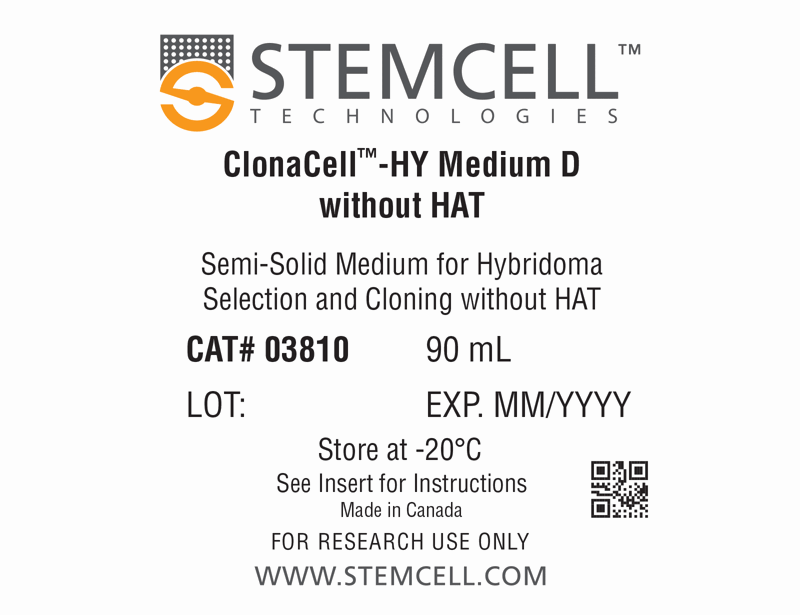ClonaCell™-HY Medium D without HAT
Semi-solid methylcellulose-based medium for hybridoma selection and cloning, without HAT (serum-containing)
概要
ClonaCell™‐HY Medium D without HAT is a semi-solid methylcellulose-based medium that does not contain any selection agents such as HAT (hypoxanthine, aminopterin, and thymidine), enabling alternative hybridoma or myeloma selection methods to be used. This product can be used to select and clone myelomas or hybridomas in one step by adding an appropriate selection agent to the medium. Individual parental clones and their progeny remain localized together in the semi-solid matrix as they grow to form distinct colonies. This prevents the loss of rare clones by overgrowth from faster-growing cells, as can occur during selection in a liquid medium, and facilitates the isolation of monoclonal colonies. The colonies can be easily picked from the semi-solid medium by manual or robotic methods and dispersed into a liquid medium for screening and expansion. This serum-containing medium has been verified for use in mouse and rat hybridoma development and reportedly is compatible for production and cloning of myelomas and/or hybridomas using lymphocytes from a variety of host animals including human, mouse, rat, and hamster.
Benefits of semi-solid cloning:
• Individual cells are suspended in viscous medium and form physically separated, discrete colonies that are easily isolated.
• Monoclonal cell lines are isolated in less time using fewer resources compared with selection and cloning by limiting dilution.
• Diverse clones with a wide range of growth rates and productivities form discrete colonies in the viscous medium. As a result, rare and high-producing clones can be individually isolated more easily using simultaneous selection and cloning in semi-solid medium compared with selection in bulk liquid cultures.
Benefits of semi-solid cloning:
• Individual cells are suspended in viscous medium and form physically separated, discrete colonies that are easily isolated.
• Monoclonal cell lines are isolated in less time using fewer resources compared with selection and cloning by limiting dilution.
• Diverse clones with a wide range of growth rates and productivities form discrete colonies in the viscous medium. As a result, rare and high-producing clones can be individually isolated more easily using simultaneous selection and cloning in semi-solid medium compared with selection in bulk liquid cultures.
Advantages
• Time savings: Hybridoma selection and cloning are combined into one step
• Resource savings: Single-cell derived hybridomas form visible discrete colonies in semi-solid medium, and are easy to pick and transfer to liquid medium for screening and expansion
• Cloning efficiency: Individual cells are suspended and immobilized in semi-solid medium, preventing loss of rare, high-producing clones due to overgrowth
• Customizable: Allows user to adapt an existing selection method
• Resource savings: Single-cell derived hybridomas form visible discrete colonies in semi-solid medium, and are easy to pick and transfer to liquid medium for screening and expansion
• Cloning efficiency: Individual cells are suspended and immobilized in semi-solid medium, preventing loss of rare, high-producing clones due to overgrowth
• Customizable: Allows user to adapt an existing selection method
Contains
• DMEM
• Methylcellulose
• Serum
• Gentamicin
• 2-Mercaptoethanol
• Phenol red
• L-Glutamine and other supplements
• Other ingredients
• Methylcellulose
• Serum
• Gentamicin
• 2-Mercaptoethanol
• Phenol red
• L-Glutamine and other supplements
• Other ingredients
Subtype
Semi-Solid Media, Specialized Media
Cell Type
Hybridomas
Species
Human, Mouse, Rat, Other
Application
Cell Culture, Hybridoma Generation, Semi-Solid Cloning
Brand
ClonaCell
Area of Interest
Antibody Development, Cancer Research, Cell Line Development, Hybridoma Generation
Formulation
Methylcellulose-Based
技术资料
| Document Type | 产品名称 | Catalog # | Lot # | 语言 |
|---|---|---|---|---|
| Product Information Sheet | ClonaCell™-HY Medium D without HAT | 03810 | All | English |
| Special Protocol | ClonaCell™-HY Medium D without HAT | 03810 | All | English |
| Manual | ClonaCell™-HY Medium D without HAT | 03810 | All | English |
| Safety Data Sheet | ClonaCell™-HY Medium D without HAT | 03810 | All | English |
数据及文献
Publications (1)
Journal of Virological Methods 2015 NOV
Generation of monoclonal antibodies specific of the postfusion conformation of the Pneumovirinae fusion (F) protein
Abstract
Abstract
Paramyxovirus entry into cells requires fusion of the viral and cell membranes mediated by one of the major virus glycoproteins, the fusion (F) glycoprotein which transits from a metastable pre-fusion conformation to a highly stable post-fusion structure during the membrane fusion process. F protein refolding involves large conformational changes of the protein trimer. One of these changes results in assembly of two heptad repeat sequences (HRA and HRB) from each protomer into a six-helix bundle (6HB) motif. To assist in distinguishing pre- and post-fusion conformations of the Pneumovirinae F proteins, and as extension of previous work (Palomo et al., 2014), a general strategy was designed to obtain polyclonal and particularly monoclonal antibodies specific of the 6HB motif of the Pneumovirinae fusion protein. The antibodies reported here should assist in the characterization of the structural changes that the F protein of human metapneumovirus or respiratory syncytial virus experiences during the process of membrane fusion.


